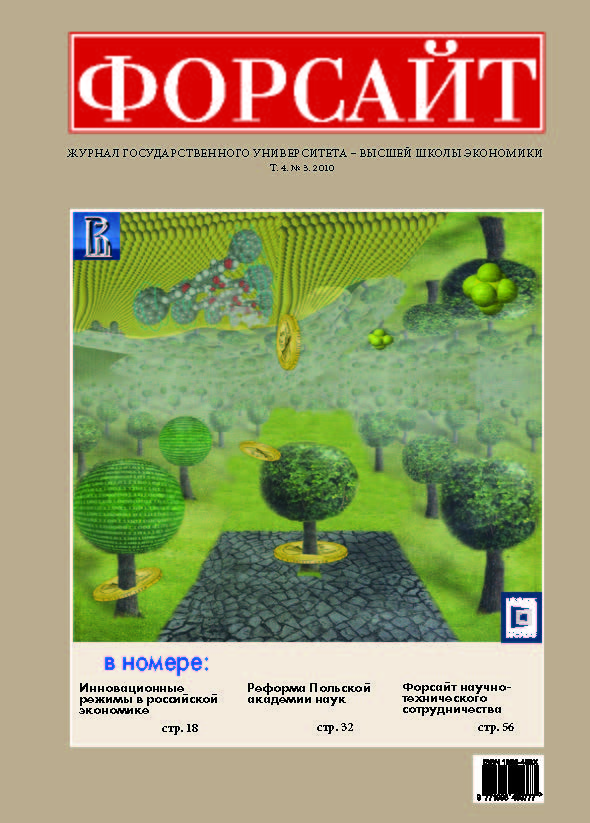Abstract
The paper discusses methodologies used to adapt to the Russian context the usual measures of STI performance, developed and implemented under the framework of the European Manufacturing Survey (EMS), and reports on results. Two rounds of surveys were conducted in 2009-2010 covering around 2000 Russian companies. The third round is planned for 2012. The paper outlines how innovative activities in the real sector of the Russian economy can be measured.
The EMS toolkit must be significantly adapted for the goals of the Russian survey. The authors harmonized their approach with the guidelines of the Oslo Manual. They covered the manufacturing and service sectors. Since the results show implications of the global crisis and the performance of the tools of state regulation, it was important to use a methodology comparable to that of the EMS on key parameters.
The questionnaire developed to survey Russian companies aimed to capture the complexity of innovation activity. It provides information on such indicators as the availability of completed and early-stage innovations, the technological level of production, the structure of collaborative relations, and environmental and resource sparing issues.
The outcome of the project is a new source of empirical data for analyzing innovation by key firms in regard to technological and modernizing organizational issues. The results showed differences by sector for the following: innovation funding priorities; motivation/stimuli to innovation activity; the level of competition in various markets; factors impeding innovation; the level of development of innovation management tools; and the scope of firms’ demand for innovation infrastructure.
The paper shows that far from all Russian firms considered “innovative” focus in a straightforward manner on innovation. Most industrial companies act according to in-house non-market-based rules of competition. These firms are very pessimistic about the prospects of promoting their own products in new markets. Innovation (especially radical) is not a business priority.
Finally, the paper shows how results of the survey can be used in theoretical and applied research on innovation in Russia and develops policy recommendations.
References
Archibugi D. (2001) Pavitts taxonomy sixteen years on: a review article//Economics of Innovation and New Technology. № 10. P. 415-425.
Arvanitis S., Hollenstein H. (1997) Innovative Activity and Firms Characteristics: An Exploration of Clustering at Firm Level in Swiss Manufacturing//OECD Workshop on Cluster Analysis and Cluster-based Policy. Amsterdam. P. 10-11.
Arvanitis S., Hollenstein H. (2001) The Determinants of the Adoption of Advanced Manufacturing Technology//Economics of Innovation and New Technology. № 10. Vol. 5. P. 377-414.
Castellacci F. (2007) Technological regimes and sectoral differences in productivity growth//Industrial and Corporate Change. № 16 (6). P. 1105.
Dosi G. (1982) Technological paradigms and technological trajectories: A suggested interpretation of the determinants and directions of technical change//Research policy. № 11. P. 147-162.
Dosi G. (1988) Sources, procedures, and microeconomic effects of innovation//Journal of economic literature. № 26. P. 1120-1171.
Evangelista R. (2000) Sectoral Patterns of Technological Change in Services//Economics of Innovation and New Technology. № 9. Vol. 3. P. 183-222.
Hatzichronoglou T. (1997) Revision of the high-technology sector and product classification//OECD Science, Technology and Industry Working Papers.
Innovation in Firms (2008) Findings from a Comparative Analysis of Innovation Surveys Microdata//STI Outlook 2008 -Global Dynamics in Science, Technology and Innovation. Paris: OECD.
Kline S.J., Rosenberg N. (1986) An overview of innovation//In: Landau R. and Rosenberg N. (eds.) The positive sum game. Washington D. C.: National Academy Press. P. 275-305.
Malerba F., Orsenigo L. (1993) Technological Regimes and Firm Behavior//Industrial and corporate change. № 2. P. 45-71.
Nelson R.R., Winter S.G. (1982) An evolutionary theory of economic change. Harvard University Press, Cambridge, Massachusetts and London, England.
OECD (2008) OCED Science, Technology and Industry Outlook. Paris.
Pavitt K. (1984) Sectoral patterns of technical change: Towards a taxonomy and a theory//Research Policy. № 13. P. 343-373.
Schumpeter J. (1934) The Theory of Economic Development. Harvard University Press. Cambridge. USA.
Winter S. (1984) Schumpeterian competition in alternative technological regimes//Journal of Economic Behavior & Organization. Vol. 5. № 3-4. P. 287-320.
Гохберг Л. М., Кузнецова И. А. (2009) Инновации в российской экономике: стагнация в преддверии кризиса?//Форсайт, № 3 (10). С. 28-46.
Индикаторы инновационной деятельности: 2009 (2009) М.: ГУ-ВШЭ.

This work is licensed under a Creative Commons Attribution 4.0 International License.

